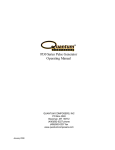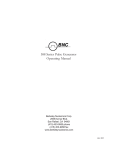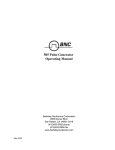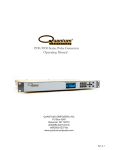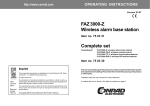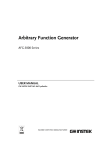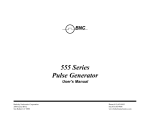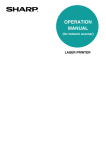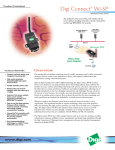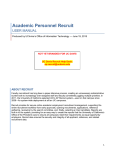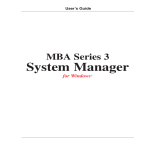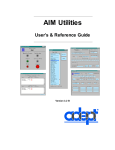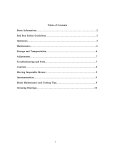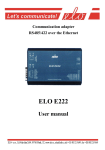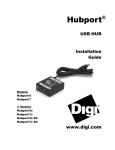Download BNC588 - DAQ Plone Site
Transcript
BNC 588 Series Pulse Generator Operating Manual Berkeley Nucleonics Corp. 2955 Kerner Blvd. San Rafael, CA 94901 (415) 453-9955 phone (415) 453-9956 fax www.berkeleynucleonics.com rev 3.0 Contents 1 Introduction .................................................................. 1 Technical Support ............................................................................................................... 2 Warranty ............................................................................................................................. 2 Package Contents ............................................................................................................... 2 Safety Issues ....................................................................................................................... 3 2 Front Panel Overview ................................................. 5 588 Front Panels .............................................................................................................. 6 Display Layout and Indicators ........................................................................................... 6 Description of Front-Panel Area ......................................................................................... 6 Keypads ............................................................................................................................... 6 3 Pulse Concepts & Pulse Generator Operation ...... 7 Counter Architecture Overview ......................................................................................... 8 System Timer Functions ..................................................................................................... 8 Channel Timer Functions .................................................................................................. 9 Output Multiplexer ............................................................................................................. 9 Dependent & Independent Timing Events ........................................................................ 9 Navigating the 588 Front Panel .................................................................................. 9 Selecting Menus .................................................................................................................. 9 Selecting Menu Items ....................................................................................................... 10 Numeric Input Mode ......................................................................................................... 10 Entering Non-Numeric Parameters ................................................................................. 10 Alphanumeric Input Mode ............................................................................................... 10 Enabling System Output .................................................................................................. 10 Enable/Disable Channel Output ...................................................................................... 10 Rearming the Channel Timers ......................................................................................... 10 Setting Pulse Timing Parameters .................................................................................... 10 Setting Pulse Output Parameters .................................................................................... 11 Using the Output Multiplexer .......................................................................................... 11 Setting System Internal Rate ........................................................................................... 11 4 588 Menus .................................................................... 13 588 Menu Structure ...................................................................................................... 14 System Mode Menu ....................................................................................................... 16 Setting System Mode of Operation ................................................................................... 16 Channel Menus .............................................................................................................. 16 Enabling Channel Output ................................................................................................ 17 Setting the Channel Timing Parameters ........................................................................ 17 Setting Pulse Output Configuration ................................................................................ 17 Setting Pulse Mode of Operation ...................................................................................... 17 Delaying the Start of Channel Output ............................................................................. 17 Configuring the Channel Multiplexer ............................................................................. 17 Advanced Channel Menus .......................................................................................... 18 Setting the Sync Source .................................................................................................... 18 Setting Channel Gate Control .......................................................................................... 18 Gate Menu ....................................................................................................................... 18 Enabling System Gate ...................................................................................................... 19 Trig Menu ....................................................................................................................... 19 Enabling System Trigger ................................................................................................. 19 Rate Menu ....................................................................................................................... 19 Setting the Clock Source and Internal Rate .................................................................... 19 Setting the Output Reference ........................................................................................... 19 System Menu .................................................................................................................. 21 Setting System Communication Parameters ................................................................... 21 Setting Keypad Parameters.............................................................................................. 21 Setting the Auto Start Mode ............................................................................................. 21 Setting the Display Decimal Mark ................................................................................... 21 Setting the Display Brightness ........................................................................................ 21 Store Menu ..................................................................................................................... 21 Storing a Configuration .................................................................................................... 21 Recall Menu ...................................................................................................................... 21 Recalling System Configurations ..................................................................................... 21 5 Operating the 588 ....................................................... 23 Quick Start - Normal Internal Rate Generator Operation ................................. 24 Quick Start - Normal External Trigger Operation ............................................... 24 System Timer Overview ............................................................................................... 25 To Use Continuous Mode .................................................................................................. 25 To Use Single Shot Mode .................................................................................................. 25 To Use System Burst Mode Function ............................................................................... 26 To Use System Duty Cycle Function ................................................................................ 26 Channel Timer Overview ............................................................................................ 26 To Use Normal Mode Function ......................................................................................... 26 To Use Channel Single Shot Function ............................................................................. 27 To Use Channel Burst Mode Function............................................................................. 27 To Use the Channel Duty Cycle Function ....................................................................... 27 To Use the Channel Gating Function .............................................................................. 28 External Input Overview ............................................................................................ 28 To Generate a Pulse on Every Trigger Input .................................................................. 28 To Generate a Burst of Pulses on Every Trigger Input................................................... 29 To Start a Continuous Stream of Pulses Using the External Trigger ............................ 29 To use the External Gate to Control the System ............................................................. 30 6 Programming the 588 ................................................ 31 Personal Computer to Pulse Generator Communication ............. 32 RS232 Interface Overview ...................................................................... 32 USB Interface Overview ......................................................................... 32 Ethernet Interface Overview ................................................................ 34 Programming Command Types and Format .................................... 34 Line Termination...................................................................................... 34 IEEE 488.2 Common Command Format .............................................. 35 SCPI Command Keywords ..................................................................... 35 SCPI Command Format .......................................................................... 36 SCPI Format .............................................................................................. 36 SCPI Keyword Separator ....................................................................... 36 SCPI Optional Keywords........................................................................ 36 SCPI Specific and Implied Channel .................................................... 36 SCPI Parameter Types ............................................................................ 37 Error Codes ................................................................................................ 37 Programming Examples ......................................................................... 37 588 SCPI Command Summary............................................................... 38 588 SCPI Command Summary............................................................... 39 588 SCPI Command Summary............................................................... 40 588 SCPI Command Summary............................................................... 41 IEEE 488.2 Common Commands ........................................................... 42 Appendix ......................................................................... 43 Appendix Appendix Appendix Appendix Appendix A - 588 Specifications ........................................................... 44 B - Safety Symbols ................................................................. 46 C - Com ..................................................................................... 50 D - Ethernet Connectivity ................................................... 52 E - External Clock ................................................................. 54 1 Introduction 1 Introduction This manual is a reference designed to familiarize you with the Berkeley Nucleonics 588 series pulse generator and is arranged so that you can easily find the information you’re looking for. Generally, each topic has its own section and no section assumes that you’ve read anything else in the manual. Technical Support For questions or comments about operating the 588 -- our technical staff can be reached via one of the following methods: - Phone - (415) 453-9955 - Fax - (415) 453-9956 - Internet - www.berkeleynucleonics.com Warranty In addition to a 30-day money back guarantee, the 588 has a two-year limited warranty from the date of delivery. This warranty covers defects in materials and workmanship. Berkeley Nucleonics will repair or replace any defective unit. Contact us for information on obtaining warranty service. Package Contents The box you receive should contain the following: - 588 Pulse Generator - AC Power Cord - User’s Manual on Disc Contact Berkeley Nucleonics (415) 453-9955 if any parts are missing. 2 Safety Issues Normal use of test equipment presents a certain amount of danger from electrical shock because testing must be performed where exposed voltage is present. An electrical shock causing 10 milliamps of current to pass through the heart will stop most human heartbeats. Voltage as low as 35 VDC or RMS AC should be considered dangerous and hazardous since it can produce a lethal current under certain conditions. Higher voltages pose an even greater threat because such voltage can easily produce a lethal current. Your normal work habits should include all accepted practices that will prevent contact with exposed high voltage, and steer current away from your heart in case of accidental contact with a high voltage. You will significantly reduce the risk factor if you know and observe the following safety precautions: • If possible, familiarize yourself with the equipment being tested and the location of its high-voltage points. However, remember that high voltage may appear at unexpected points in defective equipment. • Do not expose high voltage needlessly. Remove housing and covers only when necessary. Turn off equipment while making test connections in highvoltage circuits. Discharge high-voltage capacitors after shutting down power. • When testing AC powered equipment, remember that AC line voltage is usually present on power input circuits, such as the on-off switch, fuses, power transformer, etc. • Use an insulated floor material or a large, insulated floor mat to stand on, and an insulated work surface on which to place equipment. Make certain such surfaces are not damp or wet. • Use the time-proven “one hand in the pocket” technique while handling an instrument probe. Be particularly careful to avoid contact with metal objects that could provide a good ground return path. • Never work alone. Someone should always be nearby to render aid if necessary. Training in CPR first aid is highly recommended. 3 4 2 Front Panel Overview 5 Front Panel Overview 588 Front Panels Display Layout and Indicators A graphical display module displays parameters and status information. The status information is located in the upper-left corner of the display, between the two brackets. There are three enunciators: • Vertical Arrow • Blinking Light Indicates there are additional pages to the current menu. Indicates the unit is actively generating pulses, or armed and waiting for an external trigger. The upper-right side of the display contains the title of the currently displayed menu. The rest of the display is used for system parameters. The display brightness may be adjusted, allowing the instrument to be used under various lighting conditions. Description of Front-Panel Area Keypads Two keypad areas provide fast access to various menus and easy editing of system parameters. • Menu Keypad • Arrow Keypad 6 Provides one touch access to the channel, trigger, gate and system menus for setting up the appropriate parpameters. The Page button will allow you to page through the multiple levels fo a menu, if multiple levels exist. The up/down arrows are used to increment/decrement the current parameter (indicated by the blinking cursor). The position of the cursor controls the step size for each increment. The right/left arrow moves the cursor to different positions within the current parameter. The NEXT key selects the next parameter in the currently displayed menu. 3 Pulse Concepts and Pulse Generator Operations 7 Pulse Concepts and Pulse Generator Operation Counter Architecture Overview Arm Gate * Start To Internal System Tim er and S ystem Mode Generator Internal To Pulse RUN Command External Input Start Gate ** Arm Channel Timers and Channel Mode Generators Output MUX Output Pulses * Start source is: RUN button inModes Internal Modes *Start source is: RUN button in Internal ternalini nput i n E xternal trigger modes ExternalEx input External Trigger modes *TRG command via Serial/GPIB access ** Channels are armed by the RUN button. In single s hot and burst modes channells m ay be r earmed by pressing the R UN a s econd time. **Channels are armed by the RUN button. In single shot and burst modes channels may be rearmed by pressing the RUN button. System Timer Functions The System Timer functions as a non-retriggerable, multi-vibrator pulse generator. This means that once started, depending on the mode, the timer will produce pulses continuously. Before pulses can be generated, the timer must be armed and then receive a start pulse. Arming the counter is done by pressing the RUN/STOP key. With external trigger disabled, the RUN/STOP key also generates the start command for the counter. With external trigger enabled, the external trigger provides the start pulse. In either case, once started, the counter operation is determined by the System Mode Generator. Standard modes include: • • • • Continuous Single Shot Burst Duty Cycle Once started To pulses are generated continuously. One To pulse is generated for each start command. ‘n’ To pulses are generated for each start command. Once started To pulses cycle on and off continuously. The To pulses are distributed to all of the start inputs of the Channel Timers and Mode Generators 8 Channel Timer Functions The Channel Timer functions as a non-retriggerable, delayed, one shot pulse generator. This means that the timer will only generate one delayed pulse for every start pulse received. Once the channel timer has started counting, additional start pulses will be ignored until the pulse has been completed (nonretriggerable). The start pulse for each channel is provided by the internal To pulse generated by the Internal System Timer. Whether or not a pulse is generated for each To pulse is determined by the Channel Mode Generator. Standard modes include: • Normal • Single Shot • Burst • Duty Cycle A pulse is generated for each To pulse. One pulse is generated at the first To pulse, after which output is inhibited. A pulse is generated for each To pulse, 'n' times, after which output is inhibited. ‘n’ pulses are generated for each To pulse after which the output is inhibited for ‘m’ times. The cycle is then repeated. Different modes may be selected for each output, allowing a wide variety of output combinations. Each output may also be independently disabled or gated (using the external gate input). Output Multiplexer The output of the Channel Timers are routed to a set of multiplexers. This allows routing of any or all Channel Timers to any or all of the unit outputs. In the normal mode of operation, the output of the nth Channel Timer is routed to the Tnth output connector. As an example, if a double pulse is required on Channel A output, one can multiplex the Channel A timer with the Channel B timer adjusting each timer to provide the necessary pulses. Dependent & Independent Timing Events The 588 allows the user to control the relationship between the Channel Timers by setting the sync source for each timer. Independent events are all timed relative to the internal To start pulse. Dependent events may be linked together by setting the sync source to the controlling event. This allows the instrument to match the timed events and adjustments can be made in one event without detuning the timing between it and a dependent event. Navigating the 588 Front Panel Selecting Menus Parameters are grouped in menus, selectable using the function keys. To select the output channel parameters press the letter key corresponding to the desired channel. Menus may include a number of different pages, each page containing up to four parameters. The status block in the upper-left corner of the display shows a vertical arrow if the current menu contains addtional pages. 9 Press the Page button to select the next page. There may be multiple channel menus depending upon your unit. Secondary menus can be accessed by pressing the letter key of that channel a second time. There are also individual menu keys for the gate (GATE), trigger (TRIG), and system (MENU) menus. Depending upon your unit, each of these menus may have multiple pages, accessed by the Page button, or secondary menus, accessed by pressing that particular function key a second time. Selecting Menu Items Within a menu, the blinking cursor indicates the current menu item for editing. The NEXT will select a different menu item. Numeric Input Mode When the current item is numeric, the system enters the Numeric Input Mode. In this mode data may be edited using the arrow keypad. The Left and Right arrow keys are used to select a digit to edit. The selected digit blinks to identify itself as the active digit. The Up and Down arrow keys are then used to increment or decrement this digit. Entering Non-Numeric Parameters When the current item is non-numeric, the Up and Down arrow keys are used to select among different options for the parameter. If the item is an on-off toggle, the Up arrow enables the item and the Down arrow disables the item. Enabling System Output The RUN/STOP key is used to arm the system. With external trigger disabled, the key will arm and start pulse output. With external trigger enabled, the key will arm the pulse generator. Pulse output then starts after the first valid trigger input. Pressing the RUN/STOP key a second time disables the pulse generator. Enable/Disable Channel Output At the top of each channel menu page is a parameter to enable or disable the output of the channel. Each channel may be individually enabled or disabled. Rearming the Channel Timers If there are channels currently running in normal mode, single shot and burst channels can be re-armed without affecting the timing on normal mode channels by pressing function RUN/STOP. Setting Pulse Timing Parameters Pulses are defined by a delay, from their sync or start pulse to the active edge, and a width. Wid: Dly: 10 Sets the width of the active portion of the pulse. Sets the delay from the sync source to the start of the pulse. NOTE: If Wid + Dly + 75ns (hardware reset time) > To Period, the correct pulsewidth will be generated but at a slower rate. Setting Pulse Output Parameters There are two basic types of outputs available on the 588: (a) TTL/CMOS compatible outputs; (b) adjustable amplitude outputs. Out: Pol: Ampl: Selects between TTL/CMOS mode and Adjustable mode when both are available on a single output. Sets the voltage polarity of the pulse, active high or active low. Note: All outputs are positive - negative voltages are not supported. In adjustable mode, the unloaded output voltage is set. The actual output voltage will depend on the load impedance. For example: If the load is 50 ohms, the output will be 50% of the stated voltage. Using the Output Multiplexer Each output channel includes a multiplexer which allows routing any or all of the timer outputs to the physical output. This allows double pulses and other complex pulse trains to be generated. -HGFEDCBAMux: -00000101The multiplexer is represented by a “n” bit binary number as shown above. “n” is the number of channels. Each bit represents a channel timer, which is enabled by setting the bit to one. In the above example, timers A and C are combined on the current output. Setting System Internal Rate Parameters The internal To period controls the fundamental output frequency of the system. Each channel may operate at submultiples of the fundamental frequency using their duty cycle mode. Source: Per: Sets the reference source for the internal To Period. Sets the internal To Period. To set the system Internal Rate - Menu key and then use the arrow keys to specify the To Period. 11 12 4 588 Menus 13 588 Menus 588 Menu Structure System MODE Menus To Mode To Mode To Mode To Mode MOD E: C onti nuous MOD E: Si ngle Shot MOD E: Burst MOD E: D uty C ycle # / On # / Burst # / Off CHANNEL Menus Timing Parameters Pulse C onfiguration C hannel Enable C hannel Enable Polari ty Pulsewi dth Output Type: Adjustable D elay Output Level Channel Mode Channel Mode Channel Mode Channel Mode C ha nne l E na b le C ha nne l E na b le C ha nne l E na b le C ha nne l E na b le C ha nne l E na b le Mode: Normal Mode: S i ng le S ho t Mode: B urs t Mode: D uty C yc le He lp L i ne # / On Mux Wa i t M e n u Multiplexer Menu Wa i t C o unt # / Off Advanced CHANNEL Menus Advanced Timing Parameters C hannel Gated Operation C hannel Gated Operation C ha nne l E na b le C ha nne l E na b le C ha nne l E na b le S ync S o ur c e Ga te E na b le : D i s a b le d Ga te E na b le : <me tho d > Gate P olari ty 14 Menu R ate Source R eference Out Source Ref Out To Peri od TRIG Menu Trig Mode Trig Mode Tri g D i sabled Tri g: <tri g mode> Threshold E dge GATE Menu Gate Mode Gate Mode Gate D i sabled Gate: Enabled Threshold Polari ty SYSTEM Menus Comm. Parameters Comm. Parameters K e yp ad Parameters Misc. Parameters Interface: RS232 Interface: USB Key Repeat Rate Auto Start Key Volume Decimal Mark Baud Rate Echo Enable LCD Brightness STORE Menu RECALL Menu Store Menu Recall Menu Configuration # Configuration # Name Name Help Line Help Line 15 System Mode Menu To Mode To Mode To Mode To Mode MOD E: C onti nuous MOD E: Si ngle Shot MOD E: Burst MOD E: D uty C ycle On C ycle # / Burst Off C ycle Setting System Mode of Operation The MODE menu sets the To system timer mode. The menu will show the extra set parameters (Burst, On & Off) only when they are appropriate. • Mode: Selects the To mode: Continuous, Single Shot, Burst or Duty Cycle mode. Sets the number of pulses to be generated when in Burst mode. Sets the number of pulses to be generated during each on cycle. Sets the number of pulses to skip each during off cycle when in the Duty Cycle mode. • Burst: • On: • Off: *NOTE: Any mode may be started by either the RUN/STOP key in the internal trigger mode or armed by the RUN/STOP key and started by an external trigger in the external trigger mode. In the single shot and burst modes, (internally triggered) the unit disarms itself at the end of the pulse train. Pressing the RUN/STOP key after the unit has been disarmed will generate a new pulse train. Channel Menus Timing Parameters Pulse C onfiguration C ha nne l E na b le C ha nne l E na b le P olari ty P uls e wi d th O u t p u t Ty p e : A d jus ta b le D elay Outp ut L e ve l Channel Mode Channel Mode Channel Mode Channel Mode C ha nne l E na b le C ha nne l E na b le C ha nne l E na b le C ha nne l E na b le C ha nne l E na b le Mode: Normal Mode: S i ng le S ho t Mo d e : B urs t Mo d e : D uty C yc le He lp L i ne # / On Mux # / Off 16 Wa i t M e n u Wa i t C o unt Multiplexer Menu Enabling Channel Output At the top of each of the channel menu pages is a parameter to enable or disable the channel. Each channel may be individually controlled. Setting the Channel Timing Parameters To define a pulse requires two parameters: the delay to the active edge and the width of the pulse. Wid: Dly: Sets the channel pulsewidth. Sets the channel delay until the active edge. Setting Pulse Output Configuration The 588 supports two types of outputs: a high speed TTL/CMOS compatible output and for applications which require different voltage levels or higher current, an adjustable voltage output. The pulses can also be defined to be active high or active low. Pol: Out: Ampl: Sets the pulse polarity, active high or active low. Selects the output mode, TTL/CMOS or Adjustable Sets the output voltage level when in the Adjustable mode. Setting Pulse Mode of Operation Each channel may be set independently to operate in one of four modes: normal, single shot, burst, or duty cycle (within the CHANNEL menus): Mode: Brst: On: Off: Selects the mode for the current channel. Additional parameters are provided for the burst mode and the duty cycle mode. Sets the number of pulses in the burst mode to generate before inhibiting output. Sets the number of pulses to generate before inhibiting output in Duty Cycle Mode. Sets the number of pulses to inhibit before repeating the On Cycle in Duty Cycle Mode. Delaying the Start of Channel Output Within any channel mode, the output of the channel can be delayed using the wait parameter (within the CHANNEL menu): Wait: Sets the number of To pulses to wait until enabling the channel output. Configuring the Channel Multiplexer To define which channels are fed into the channel multiplexer, the corresponding bit for the desired channel to add should be set to 1. All desired omitted channels should have the corresponding bit set to 0. 17 Mux: Enable/disable bitfield. Advanced Channel Menus Advanced Timing Parameters C hannel Gated Operation C hannel Gated Operation C ha nne l E na b le C ha nne l E na b le C ha nne l E na b le S ync S o ur c e Ga te E na b le : D i s a b le d Ga te E na b le : <me tho d > Gate P olari ty Setting the Sync Source Although each channel receives its start pulse from the internal To pulse, logically the start pulse can be assigned such that the delay entered is relative to the To pulse or any other channel pulse. This allows dependent events to link. The unit will not allow a circular chain of sync sources that would result in a channel triggering itself. The delay entered is relative to the selected sync source. Sync Source: Selects the channel sync source. Setting Channel Gate Control When the global gate is set (Chan Menu), the channel can then use the gate input with independent behavior from other channels. Gate: Logic: Enables the GATE input for the channel by setting the method of output control used with the gating function. Sets the logic level used with the gating function, either active high or active low. “Pulse Inhibit” method - the gate prevents the channel from being triggered by the channel’s trigger source pulse. If a pulse has already started when the gate disables the channel, the pulse will continue normal output but will not restart on the next trigger pulse. “Output Inhibit” method - the gate leaves the base triggering alone and enables/ disables the output directly. Gate Menu Gate Mode Gate Mode Gate: D i sabled Gate: <method> Threshold Polari ty 18 Enabling System Gate Enables the use of the GATE input as a trigger inhibit or output control for all channels simultaneously, or on a per channel basis. Mode: Level: Logic: Selects between disabling the GATE inputs and method of output control Sets the gating threshold. Sets the active logic level. Trig Menu Trig Mode Trig Mode Tri g: D i sabled Tri g: <tri g mode> Threshold E dge Enabling System Trigger Enable the use of the TRIG input by the system timer as a trigger source. Mode: Level: Edge: Selects between disabling/enabling the trigger mode(s). Sets the trigger threshold. Selects between rising edge / falling edge as the trigger source when a trigger mode is enabled. Rate Menu R ate Source R eference Out Source Ref Out To Peri od Setting the Clock Source and Internal Rate Source: Per: Selects the internal or external clock source from which the unit will operate. Sets the To period which determines the fundamental output frequency of the unit. Setting the Output Reference Ref Out: Selects the frequency of the output reference for synchronizing with external system components. 19 System Menu C omm. Parameters C omm. Parameters K e yp ad Parameters Misc. Parameters Interface: RS232 Interface: USB Key Repeat Rate Auto Start Baud Rate Key Volume D eci mal Mark Echo Enable Knob Volume LC D Bri ghtness Setting System Communication Parameters The 588 comes with a standard RS232 serial port and USB port. The unit will not respond to computer commands unless these ports are properly configured. Interface: Baud Rate: Echo: Address: RS232, USB, Etherenet (optional) Selects the baud rate for the selected interface. Selects whether to echo characters back to the host computer or not. Sets the GPIB address. Setting Keypad Parameters The rate at which a key will repeat itself when held down may be set. This can be used to provide a controlled rate at which a parameter is incremented. In addition, the volume of the beep can be controlled for both the keypad and the adjustable knob. Key Rate: Key Vol: Sets the rate at which the keys will repeat when held down. Sets the beep volume for the keypad. Setting the Auto Start Mode The unit may be configured to automatically start generating pulses after power up. Setting the Display Decimal Mark Mark: Selects the format of the decimal mark, “.” or “,”. Setting the Display Brightness LCD Adjusts display brightness. 20 Store Menu Store Menu C onfi gurati on # Name Help Li ne Storing a Configuration Use the following procedure to store a complete system configuration: • Set all parameters to the desired value. • Select a configuration number. *NOTE: You cannot store to the zero location, as that contains the factory default values. • Label the configuration as desired. • From the Store menu, press the store button sequence (Page). *NOTE: When the unit powers up it will recall the last stored or recalled configuration. Any changes to the configuration which were not saved are not restored. Recall Menu R ecall Menu C onfi gurati on # Name Help Li ne Recalling System Configurations Use the following procedure to recall a stored or default system configuration: • Enter the Recall Menu. • Select a configuration number. • From the Recall Menu, press the recall key sequence (Page). *Note: Configuration 0 is the factory default setting. 21 22 5 Operating the 588 23 Operating the 588 Quick Start - Normal Internal Rate Generator Operation The 588 has a powerful set of functions providing a number of modes of operation for the internal or “System” rate generator (To). Most of these functions can be ignored if a simple continuous stream of pules is required. Starting from the default settings, which can be recalled by recalling configuration 0, the following parameters need to be set: Pulse Width, Delay Enter the Channel menus by pressing the letter key. Enter the required pulse width and delay. Repeat for each output channel. To Period Enter the rate menu. Set the desired pulse period. Note that in general, the pulse delay plus the pulse width, plus a 75ns hardware reset constant, for any channel must be less than the To period. Start Press the RUN/STOP key to start generating pulses. Stop Press the RUN/STOP key a second time to stop generating pulses. Quick Start - Normal External Trigger Operation To generate a single pulse for every external trigger event, based on the default configuration 0, the following parameters need to be set: System Mode Enter the MODE menu. Select Single Shot mode. Trig Enter the TRIG menu by pressing the TRIG key. Select Triggered. Level Press the NEXT key until the Level parameter is displayed. Set the trigger threshold voltage to approximately 50% of the trigger signal amplitude. 24 Edge Press the NEXT key until the Edge parameter is highlighted. Set the instrument to trigger off the rising edge or falling edge as desired. Pulse Width, Delay Enter the Channel menus by pressing the letter key. Enter the required pulse width and delay. Repeat for each output channel. Start Press the RUN/STOP key to start/arm the instrument. The 9520 will now generate a pulse for every valid trigger. Stop Press the RUN/STOP key a second time to stop/disarm the instrument (i.e. to stop generating pulses). System Timer Overview For internal operation, the 588 contains a timer and mode generator which generates an internal To clock that is used to trigger all the channel timers. System modes are controlled via the MODE menu. To Use Continuous Mode The RUN/STOP button starts and stops a continuous pulse stream at the rate specified by the Rate menu. This corresponds to the normal output mode for most pulse generators. To generate a continuous stream of pulses: - within the system Mode menu Mode Select Continuous for the system mode. - within the Rate menu Source Select the system oscilator or the external clock in frequency. Period Set the desired period. Pressing the RUN/STOP key will now generate a stream of To pulses, at a rate specified by the period parameter. To Use Single Shot Mode To generate a single pulse with every press of the RUN/STOP key: - within the system Mode menu Mode Select Single Shot for the system mode. Pressing the RUN/STOP key will now generate a single pulse. 25 To Use System Burst Mode Function The RUN/STOP button generates a stream of “n” To pulses, where “n” is specified by the Burst parameter. The rate is specified in the Rate menu. Pressing the RUN/STOP button while the burst is in process will stop the output. After the burst has been completed, pressing the RUN/STOP button will generate another burst. To generate a burst of pulses: - within the system Mode menu Mode: Select the Burst mode. Burst: Set the number of pulses to produce in the burst. To Use System Duty Cycle Function The RUN/STOP button starts a continuous pulse stream which oscillates on for the “n” pulses and off for “m” pulses, where “n” and “m” are specified by the On and Off parameters, respectively. The rate is specified in the Rate Menu. To generate a stream of pulses which oscillates on for ‘n’ pulses and off for ‘m’ pulse: - within the system Mode menu Mode: Select the Duty Cycle mode. On: Set the number of pulses to produce during the on cycle. Off: Set the number of pulses to skip during the off cycle. -within the Rate menu Source Period: Select the system oscillator or the external clock in frequency. Set desired Period. Channel Timer Overview The output of each channel is controlled by two timers to generate the delay timing and the pulsewidth. All channels are simultaneously triggered, depending on the system mode, by either the internal To pulse, the external trigger, or a trigger provided by a cpu. A given channel may or may not generate a pulse depending on its own channel mode as described below. To Use Channel Normal Mode Function The Normal mode generates a continuous stream of pulses at a rate determined by the system timer: - within the Channel menus Enable: Select Enable to enable channel output. Dly: Set the desired delay. Wid: Set the desired pulsewidth. Mode: Select the Normal mode. 26 Pressing the RUN/STOP key will now generate a continuous stream of pulses. To Use Channel Single Shot Function The Single Shot mode generates a single pulse every time the RUN/STOP key is pressed. To use the Single Shot mode: - within the Channel menus Enable Select Enable to enable channel output. Delay Set the desired delay. Width Set the desired pulsewidth. Mode Select the Single shot mode. To Use Channel Burst Mode Function The Burst mode generates a burst of pulses every time the RUN/STOP key is pressed. To use the Burst mode: -within the Channel menus Enable Select Enable to enable channel output. Delay Set the desired delay. Width Set the desired pulsewidth. Mode Select the Burst mode. #/Burst Set the number of pulses to produce in the burst. To Use the Channel Duty Cycle Function To generate a stream of pulses which oscillates on for ‘n’pulses and off for ‘m’ pulses: - within the Channel menus Enable Select Enable to enable channel output. Delay Set the desired delay. Width Set the desired pulsewidth. Mode Select the Duty Cycle mode. On Cycle Set the number of pulses to produce during the on cycle. Off Cycle Set the number of pulses to skip during the off cycle. Note: Older Berkeley Nucleonics pulse generators had a divide-by-n function. The duty cycle mode is a more general case. To reproduce the divide-by-n function, set the on cycle to 1 and set the off cycle to (n-1), where “n” is the divide-by-n factor. 27 To Use the Channel Gating Function Each channel may use the external input to gate or control its output. The gate controls the triggering of the channel. To use the gate, set the following parameters - within the Channel menu Mode: In Gate Menu must be set to Channel Menu. Channel Gate: Select pulse INH or output INH. Logic: Select active high or active low. In “Pulse” method, the gate prevents the channel from being triggered by the channel’s trigger source pulse. If a pulse has already started when the gate disables the channel, the pulse will continue normal output but will not restart on the next pulse. In “Ouput” method, the gate leaves the base triggering alone and enables/disables the output directly. External Input Overview The external inputs may be used to trigger the unit or to gate the system or channel timers. When using a trigger input, the external input acts as a system start pulse. Depending on the system mode, the result of a trigger input can be either a single pulse, a burst of pulses or the start of a stream of pulses. To Generate a Pulse on Every Trigger Input To generate a pulse on every external trigger received, set the following parameters: - within the Mode menu Mode: Select the Single Shot mode. - within the Trigger menu Mode: Select Triggered mode. Level: Set the trigger threshold level. Edge: Select which edge, rising or falling, to trigger on. Pressing the RUN/STOP key will arm the unit. Once the unit is armed, it will generate a To pulse for every external trigger received. Pressing the RUN/ STOP key will disarm the unit. This mode corresponds to the normal external trigger mode found on most other pulse generators. To Generate a Burst of Pulses on Every Trigger Input To generate a burst of pulses for every external trigger received set the following parameters: -within the Mode menu Mode: Select the Burst mode. 28 Burst: Per: - within the Rate menu Source: Per: Set the number of pulses to generate in each burst.within the Rate menu Set the period between pulses. Select the system oscilator or an external clock in frequency. Set the period between pulses. - within the Trigger menu Mode: Select Triggered mode. Level: Set the trigger threshold level. Edge: Select which edge, rising or falling, to trigger on. Pressing the RUN/STOP key will arm the unit. Once the unit is armed, it will generate a set of pulses for every external trigger received. The unit is reset at the end of a burst and will generate another set of pulses upon receiving a new trigger. Triggers that occur in the middle of a burst are ignored. Pressing the RUN/STOP key will disarm the unit. To Start a Continuous Stream of Pulses Using the External Trigger The external trigger may be used to start the unit generating pulses: - within the Mode menu Mode: Select the Continuous mode. - within the Rate menu Source: Select the system oscilator or an external clock in frequency. Per: Set the period between pulses. - within the Trigger menu Mode: Select the Trigger mode. Level: Set the trigger threshold level. Edge: Select which edge, rising or falling, to trigger on. Pressing the RUN/STOP key will arm the unit. Once the unit is armed, it will begin generating pulses after an external trigger is received. Triggers that occur after the pulses start are ignored. Pressing the RUN/STOP key a second time will disarm the unit. To use the External Gate to Control the System The external gate may be used to control the output of the unit. To gate the system timer: - within the Gate menu Mode: Select Gate Menu 29 Gate: Level: Method (advanced: Select active high or active low. Set the threshold voltage for the external input. Select Pulse or output (press Function Key and then hit Channel Key; repeat to cycle through Advanced Channel Menu. - within the Mode menu Mode: Select the desired mode. - within the Rate menu Source: Select the system oscillator or an external clock in frequency.. Per: Set the period between pulses. - within the Gate menu Mode: Select pulse INH or output INH. Level: Set the gate threshold level. Logic: Select active high or active low. Pressing the RUN/STOP key will arm the unit. Once the unit is armed, it will begin generating pulses whenever the external gate input is in the active state. Pressing the RUN/STOP key a second time will disarm the unit. 30 6 Programming the 588 31 Programming the 588 Personal Computer to Pulse Generator Communication The 588 comes standard with an RS232 serial and USB interface. An Ethernet interface is available as an option. All menu settings can be set and retrieved over the computer interface using a simple command language. The command set is structured to be consistent with the Standard Commands for Programmable Instruments. Although due to the high number of special features found in the 588, many of the commands are not included in the specification. The syntax is the same for all interfaces. RS232 Interface Overview The serial port is located on the back of the 588 and uses a 9-pin D-type connector with the following pinout (as viewed from the back of the unit): 1 2 3 4 5 6 7 8 9 No Connection Tx - Transmit (to computer) Rx - Receive (from computer) DTR - Connected to pin 6 Ground DSR - connected to pin 4 RTS - connected to pin 8 CTS - connected to pin 7 No Connection The serial port parameters should be set as follows: Baud Rate Data Bits Parity Stop Bits 4800, 9600 19200, 38400, 57600, 115200 (default) 8 None 1 *The default baud rate for the RS232 is 115200. USB Interface Overview The USB interface is standard on the 588. Before this type of communication can be used, the appropriate drivers must be installed on the personal computer (pc). These drivers are included on the cd that was shipped with your unit. Please contact Berkeley Nucleonics or visit www.berkeleynucleonics.com for updated installation files and instructions. USB communication is achieved by using a mapped (virtual) COM port on the pc. The driver installation executable will obtain an unused COM port number, 32 install the USB drivers, and make that COM port number available for typical RS232 communication to the pulse generator. Hyperterminal or other common software may be used. When communicating through the mapped COM port over USB, the baud rate for the communication port used by the USB chip must match the baud rate for the COM port on the pc. Access to the USB port baud rate is done using the SCPI command “:SYSTem:COMMunicate:SERial:USB n” command, where ‘n’ is the desired communication speed. This parameter can be accessed via any communication method. The default buad rate for USB is 38400. USB communication notes: • • • • • The correct drivers must be installed on the personal computer before communication can be accomplished via USB. The BAUD rates on the pc and on the pulse generator must match for successful communication. The USB port’s BAUD rate on the pulse generator can be set using the SCPI command “:SYSTem:COMMunicate:SERial:USB n” where ‘n’ can be: o 4800 o 9600 o 19200 o 38400 (default) o 57600 o 115200 USB 1.0 specification is used. The USB cable can be removed without “unplugging” the device in the operating system environment. Echo functionality is not available on the USB port. Ethernet Interface Overview An Ethernet interface is optional on the 588. 33 The Ethernet module used is a “Digi Connect ME” module supplied by Digi Connectware, Inc. There are several ways to successfully communicate with the pulse generator over Ethernet. The two most popular methods are raw TCP/IP (such as Labview or programming with VISA libraries) and by mapping a pc COM port using the Digi Connectware’s “Realport Drivers”. Whatever method of Ethernet communication is ultimately desired, the utilities supplied by Digi Connectware (included on the cd shipped with the Ethernetoption pulse generator) will be critical to implementing the communications. Please install these utilities. Ethernet communication notes: • • The Digi Connectware’s “Digi Device Discovery” can be used to determine what IP address was assigned by the local DHCP server (if any). “Digi Device Discovery” can also be used to open a web interface to the Ethernet module. Simply double-click on the IP address that is displayed in the Digi Device Discovery utility. o o • • • Username: Password: “root” “dbps” If a mapped COM port is the desired communication method, the Digi Connectware’s “Realport Drivers” setup must be used to install the COM port on the pc. This virtual COM port is then local to the computer it was installed on. Please refer to the Digi Connectware documentation supplied on the cd, or call Berkeley Nucleonics technical support. The pulse generator’s SCPI parameter “:SYSTem:COMMunicate:SERial:USB n” is defaulted to 115200 and should not be changed for Ethernet communication, whether or not a mapped COM port is used. The virtual COM port on the pc should be set to 115200 BAUD. Echo functionality is not available on the Ethernet port. Programming Command Types and Format The 588 Pulse Generator uses two types of programming commands: IEEE 488.2 Common Commands and Standard Commands for Programmable Instruments (SCPI). The format is the same for all interfaces. Hyperterminal (in Windows) or any other generic terminal program may be used to interactively test the commands using the RS232 interface. The format of each type is described in the following paragraphs. Line Termination The pulse generator uses text-style line terminations. When a command is sent to the unit, the firmware is programmed to read characters from a communication port until it reads the line termination sequence. 34 The command string is parsed and executed after reading these characters. These characters are the “carriage return” and “linefeed”. They are ascii character set values 13 and 10 respectively (hex 0x0D and 0x0A). All command strings need to have these characters appended. When the pulse generator responds to a command, whether it is a query or a parameter change, it also appends its return strings with these characters. Coded applications could use this behavior to know when to stop reading from the unit. However, if the “echo” parameter is enabled, there will be two sets of line terminators, one following the echoed command string, and one following the pulse generator’s response. Note: The pulse generator will echo commands on the DB9 serial port only. The pulse generator responds to every communication string. If the communication string is a query, the unit responds with the queried response (or error code) followed by the line terminators. If the communication string is a parameter change, the response is “ok” (or error code) followed by the line terminators. For this reason, it is not recommended that multiple commands be stacked together into single strings as is common with some other types of instruments. It is recommended that the coded application send a single command in a string and follow immediately by reading the response from the unit. Repeat this sequence for multiple commands. IEEE 488.2 Common Command Format The IEEE 488.2 Common Commands control and manage generic system functions such as reset, configuration storage and identification. Common commands always begin with the asterisk (*) character and may include parameters. The parameters are separated from the command pneumonic by a space character. For Example: *RST *RCL 1 *IDN? <cr> <lf> <cr> <lf> <cr> <lf> SCPI Command Keywords The commands are shown as a mixture of upper and lower case letters. The upper case letters indicate the abbreviated spelling for the command. You may send either the abbreviated version or the entire keyword. Upper and/or lower case characters are acceptable. For example, if the command keyword is given as POLarity, then POL and POLARITY are both acceptable forms; truncated forms such as POLAR will generate an error; polarity, pol, and PolAriTy are all acceptable as the pulse generator is not case sensitive. 35 SCPI Command Format SCPI commands control and set instrument specific functions such as setting the pulsewidth, delay and period. SCPI commands have a hierarchical structure compose of functional elements that include a header or keywords separated with a colon, data parameters and terminators. For example: SCPI Format :PULSE1:STATE ON :PULSe1:WIDTh 0.000120 :PULSe:POL NORMal <cr> <lf> <cr> <lf> <cr> <lf> Any parameter may be queried by sending the command with a question mark appended. For example: - QUERY FORMAT :PULSE1:STATE? Will return: 1 <cr><lf> Will return: :PULSE1:WIDT? <cr><lf> 0.000120000 <cr><lf> Will return: :PULSE1:POL? <cr><lf> NORM <cr><lf> SCPI Keyword Separator A colon (:) must always separate one keyword from the next lower-level keyword. A space must be used to separate the keyword header from the first parameter. If more than one parameter is used, you must separate subsequent parameters with a comma. SCPI Optional Keywords Optional keywords and/or parameters appear in square brackets ( [ ] ) in the command syntax. Note that the brackets are not part of the command and should not be sent to the pulse generator. When sending a second level keyword without the optional keyword, the pulse generator assumes that you intend to use the optional keyword and responds as if it had been sent. SCPI Specific and Implied Channel Some commands, such as PULSe, allow specifying a channel with an optional numeric keyword suffix. The suffix will be shown in square brackets [ 1 / 2 ]. The brackets are not part of command and are not to be sent to the pulse generator. The numeric parameters correspond to the following channels: 0 = To, 1 = ChA, 2 = ChB, etc. Only one channel may be specified at a time. If you do not specify the channel number, the implied channel is specified by the :INSTrument:SELect command or the last referenced channel. 36 After power-up or reset (*RST) The instrument default is channel #1. SCPI Parameter Types The following parameter types are used: <numeric value> <boolean value> <identifier> Accepts all commonly used decimal representation of numbers including optional signs, decimal points and scientific notation: 123, 123e2, -123, -1.23e2, .123, 1.23e-2, 1.2300E-01. Represents a single binary condition that is either true or false. True is represented by a 1 or ON; false is represented by a 0 or OFF. Queries return 1 or 0. Selects from a finite number of predefined strings. Error Codes The unit responds to all commands with either: ok <cr><lf> or ?n <cr><lf> Where "n" is one of the following error codes: 1 2 3 4 5 6 7 8 Incorrect prefix, i.e. no colon or * to start command. Missing command keyword. Invalid command keyword. Missing parameter. Invalid parameter. Query only, command needs a question mark. Invalid query, command does not have a query form. Command unavailable in current system state. Programming Examples Example 1) 20 ms pulsewidth, 2.3 ms delay, 10 Hz, internal trigger, continuous operation. :PULSE1:STATE ON <cr> <lf> :PULSE1:POL NORM <cr> <lf> :PULSE:WIDT 0.020 <cr> <lf> :PULSE1:DELAY 0.0023 <cr> <lf> :PULSE0:MODE NORM <cr> <lf> :PULSE0:PER 0.1 <cr> <lf> :PULSE0:EXT:MODE DIS <cr> <lf> enables channel A sets polarity to active high sets pulsewidth to 20 ms sets delay to 2.3 ms sets system mode to continuous sets period to 100 ms (10 Hz) disables the external trigger To start the pulses use either of the following commands: :PULSE0:STATE ON <cr> <lf> :INST:STATE ON <cr> <lf> starts the pulses alternate form to start pulses. 37 Example 2) 25μs pulsewidth, 0 delay, external trigger, one pulse for every trigger. :PULSE1:STATE ON <cr> <lf> :PULSE1:POL NORM <cr> <lf> :PULSE:WIDT 0.000025 <cr> <lf> :PULSE1:DELAY 0 <cr> <lf> :PULSE0:MODE SING <cr> <lf> :PULSE:TRIG:MODE TRIG <cr> <lf> :PULS:EXT:LEV 2.5 <cr> <lf> :PULS:EXT:EDGE RIS <cr> <lf> enables channel A sets polarity to active high sets pulsewidth to 25μs sets delay to 0 sets system mode to single shot sets system to external trigger sets trigger level to 2.5 v set to trigger on rising edge To arm the instrument in external gate mode, use either of the following commands: :PULSE0:STATE ON <cr> <lf> :INST:STATE ON <cr> <lf> arms the instrument alternate form if To is currently selected A software generated external trigger can be generated by using the following command: *TRG <cr> <lf> generates a software external trigger 588 SCPI Command Summary Keyword Parameter Std/ New Comments Std Subsystem. Supports treating each channel as a logical instrument. Std Query only. Returns a comma-separated list of the names of all channels. A two channel instrument would return: To, CHA, CHB. :FULL? Std Query only. Returns a comma-separated list of the names of all channels and their associated number. A two channel instrument would return: To, 0, CHA, 1, CHB, 2. :COMMands? New Query only. Returns an indentured list of all SCPI commands. :INSTrument :CATalog? :NSELect <numeric value> Std Selects a channel using the channel's numeric value. All channel specific commands will refer to the selected channel. :SELect <identifier> Std Selects a channel using the channel's identifier string. All subsequent channel specific commands will refer to the selected channel. :STATe <boolean value> Std Enables/Disables the selected channel output. If To is selected all output is affected. Enabling To is the same as pressing the RUN button. 38 588 SCPI Command Summary Keyword Parameter [:PULSe] [0] Std/ New C omments Std Subsystem. C ontai ns commands to control the output pulse generati on. C ommands wi thout suffi x refer to the currently selected logi cal i nstrument. See INSTrument subsystem. :STATe <boolean value> Std Enables / D i sables the output for all channels. C ommand i s the same as pressi ng the RUN/STOP button. :PERi od <numeri c value> Std Sets the To peri od. :MOD e NORMal / SINGle / BURSt / D C YC le New Sets the To mode. :BC Ounter <numeri c value> New Burst C ounter. Number of pulses to generate i n the Burst mode. :PC Ounter <numeri c value> New Pulse C ounter. Number of pulses to generate duri ng on cycle of the D uty C ycle mode. :OC Ounter <numeri c value> New Off C ounter. Number of pulses to i nhi bi t output duri ng the off cycle of the D uty C ycle mode. New Subsystem. C ontai ns the commands to defi ne the C lock In parameters. :IC Lock :MOD e INT / EXT New Sets source for i nternal clock or external clock. :RATe <numeri c value> New Sets i nternal clock ci rcui try to match the i ncomi ng si gnal from the external clock source. Range i s 10MHz - 100MHz. :LEVel <numeri c value> New Sets threshold value for the clock i n ci rcui try. Ranges from 0.02V - 2.5V. :OC Lock To / 10 / 11 / 12 / 14 / 16 / 20 / 25 / 33 / 50 / 100 New Sets external clock output. To Pulse or 50% duty cycle TTL output from 10MHz to 100MHz. New Subsystem. C ontai ns the commands to defi ne the Gate functi on. :GATe :MOD e D IS/PULS/OUTP/ C HAN New Sets Global Gate Mode. D i sable, pulse i nhi bi t, output i nhi bi t, channel. :LOGi c LOW / HIGH New Sets C hannel Gate logi c level. Acti ve low or acti ve hi gh. :LEVel <numeri c value> New Sets the Tri gger Threshold. Value i s i n volts, wi th a a range of .20 to 15 Volts. New Subsystem. C ontai ns the commands to defi ne the Tri gger functi on. :TRIGger :MOD e D IS / TRIG New Sets Tri gger Mode. D i sable or TRIG (enable). :ED Ge RISi ng / FALLi ng New Selects whi ch edge (ri si ng or falli ng) to use as the tri gger si gnal. :LEVel <numeri c value> New Sets the Tri gger Threshold. Value i s i n volts, wi th a range of .20 to 15 Volts. 39 588 SCPI Command Summary K eyword P arameter :P ULS e [1 / 2 / n] Std/ New C omments Std S ubsystem. C ontai ns commands to control the output pulse generati on. Vali d suffi x range depends on the number of channels (C hA = 1, C hB = 2, etc). C ommand wi thout suffi x refers to the currently selected logi cal i nstrument. S ee INS Trument subsystem. E nables/D i sables the output pulse for selected channel. :S TATe <boolean value> Std :WID Th <numeri c value> Std S ets the wi dth or durati on of the output pulse. :D E Lay <numeri c value> Std S ets the ti me from the start of the To peri od to the fi rst edge of the pulse. :S YNC TO, C HA , C HB , C HC , C HD , etc. New S elects the S ync source. :MUX <numeri c value> New S elects whi ch ti mers are enabled as output for the current channel. :P OLari ty NORMal / C OMP lement / INVerted Std S ets the polari ty of the pulse. For NORMal operati on the second nomi nal state i s more posi ti ve than the fi rst. C OMP lement and INVerted are ali ases. For both, the second state i s more negati ve than the fi rst. New S ubsystem. C ontai ns command to control output mode. :OUTP ut :A MP Li tude <numeri c values> New S ets adjustable output level. :MOD e TTL/ A D Justable/ New S elects output A MP Li tude mode: TTL/C MOS , A D Justable. :C MOD e NORMal / S INGle / B URSt / D C YC le New C hannel Mode. S ets the channel pulse seri es output mode. :B C Ounter <numeri c value> New B urst C ounter. S ets the number of pulses to generate when channel i s i n the B URS T mode. :P C Ounter <numeri c value> New P ulse C ounter. S ets the number of pulses to generate duri ng the on cycle of the D uty C ycle Mode. :OC Ounter <numeri c value> New Off C ounter. Number of pulses to i nhi bi t output duri ng the off cycle of the D uty C ycle mode. :WC Ounter <numeri c value> New S ets the number of To pulses to delay unti l enabli ng output. :C GATe D IS / P ULS / OUTP New S ets C hannel Gate Mode. D i sable, pulse i nhi bi t, output i nhi bi t. (Global Gate Mode must be set to C HA N for thi s command to be avai lable). :C LOGi c LOW / HIGH New S ets C hannel Gate Logi c level. A cti ve low or acti ve hi gh. (Global Gate Mode must be set to C HA N for thi s command to be avai lable. :P ULS E 1 - n 40 588 SCPI Command Summary Keyword Parameter :SYSTem Std/ New C omments Std :STATe? New Query only. Returns the state of the machi ne: returns "1" i f the machi ne i s armed and/or generati ng pulses or "0" i f the machi ne has been di sarmed. :BEEPer Std Subsystem. C ontrols the audi ble beeper. :STATe :VOLume <boolean value> <numeri c value> :C OMMuni cate :SERi al Std Enables/di sables the beeper. Std Sets the volume of the beeper. Range i s 0 to 100, where 0 i s off and 100 i s maxi mum volume. Std Subsystem. C ontrols the RS232 and GPIB i nterfaces. Std Subsystem. C ontrols the physi cal confi gurati on of the RS232 port. Std Sets the baud rate for both recei vi ng and transmi tti ng usi ng the D B9 RS232 port. :BAUD 4800 / 9600 / 19200 / 38400 / 57600 / 115200 / :USB 4800 / 9600 / 19200 / 38400 / 57600 / 115200 / New Sets the baud rate for communi cati on when usi ng mapped comports for USB and Ethernet communi cati on. Must be set to the default valve (115200) for raw TC P/IP communi cati on (i .e. Labvi ew). :EC Ho <boolean value> New Enables/D i sables transmi ssi on of characters recei ved on the D B9 seri al port. :KLOC k <boolean value> New Locks the keypad. :AUTorun <boolean value> New After power-up, uni t wi ll start generati ng pulses automati cally. :VERSi on? Std Query only. Returns SC PI versi on number i n the form: YYYY.V ex. 1999.0 :SERN? New Query only. Returns the seri al number. 41 Keyword Std/ New Parameter :DISPlay Std Comments Subsystem. Contains commands to control the display. Enables/Disables automatic display update. When true, front panel display is updated with <boolean value> New serial command parameter changes. Setting to false decreases response time. :MODe :UPDate? :BRIGhtness <numeric value> New Query only. Forces update of display. Use when mode is false. New Controls intensity of display. Range is 0 to 4, where 0 is off and 4 is full intensity. IEEE 488.2 Common Commands Mnemoni c C ommand Name Parameters C omments Identi fi cati on Query Queri es the Pulse Generator Identi fi cati on. The ID wi ll be i n the followi ng format: model#-#channels-opti on#-versi on# *RC L Recall C ommand <numeri c value> Restores the state of the Pulse Generator from a copy stored i n local nonvolati le memory (0 through 12 are vali d memory blocks). *RST Reset C ommand Resets the Pulse Generator to the default state. *SAV Save C ommand *TRG Tri gger *ID N? <numeri c value> Stores the current state of the Pulse Generator i n local nonvolati le memory (1 through 12 are vali d memory blocks). Generates a software tri gger pulse. Operati on i s the same as recei vi ng an external tri gger pulse. Query Form returns the label of the last saved or recalled confi gurati on. *LBL Setup Label 42 <stri ng value> C ommand Form sets the label stri ng for the next "*sav" command. Stri ng must be i n double quotes, 14 characters max. Appendix 43 Appendix A - Specifications 588 Specifications Pulse Generation RANGE DELAY WIDTH RESOLUTION TIMEBASE TIMEBASE ACCURACY 0 - 1000s 10ns - 1000s 250ps 50MHz 25PPM INTERNAL RATE GENERATOR RATE RESOLUTION ACCURACY JITTER SETTLING BURST MODE 0.0002Hz to 20.000MHz 10ns Same as timebase 50ps 1 cycle 1 to 9,999,999 TTL/ADJUSTABLE OUTPUTS NUMBER 4 or 8 Channel Outputs LOAD 50 ohm RISE TIME 3ns typ TTL 15ns typ @ 20V (high imp) Adj 25ns typ @ 10V (50 ohms) Adj SLEW RATE >0.5 V/ns TTL >0.1V/ns Adj OVERSHOOT <100mV + 10% of pulse amplitude LEVELS TTL 0 to 4 VDC high imp 2.0 to 20.0 VDC high imp 1.0 - 10.0 VDC into 50 ohm RESOLUTION 10mV ACCURACY 1ns + .001 x Setpoint 44 EXTERNAL INPUTS TRIGGER INPUTS NUMBER RATE THRESHOLD MAXIMUM INPUT VOLT. RESOLUTION IMPEDANCE SLOPE IMPEDANCE JITTER INSERTION DELAY MINIMUM PULSE WIDTH GATE INPUTS THRESHOLD MAXIMUM INPUT VOLT. RESOLUTION POLARITY FUNCTION CHANNEL BEHAVIOR PULSE INHIBIT DELAY OUTPUT INHIBIT DELAY 0, 2 or 4 DC to 1/ (200ns + longest delay) 0.2 to 15VDC 60V Peak 10mV 1000 ohm Rising or Falling 1000 ohm 800ps RMS <180ns 2ns 0.2 to 15 VDC 60V Peak 10mV Active High/Active Low Pulse Inhibit or Output Inhibit Global w/ Individual Channel 120ns 50ns STANDARD FEATURES/FUNCTIONS COMMUNICATIONS GLOBAL GATES/TRIGGERS CHANNEL GATES/TRIGGERS EXTERNAL CLOCK IN EXTERNAL CLOCK OUT COMMAND SET COMPATIBILITY USB/RS232 2 Global Gate/Trigger Inputs Optical/Electrical Available (5ns Jitter) 10MHz - 100MHz in 1MHz increments 0.02V To, Rate, Chan, 2X ExtPLL, 1X ExtPLL, 1/2x ExtPLL, 1/2 Ext, 40 MHz, 20 MHz, 10 MHz, 5 MHz, Disabled Backwards Compatible OPTIONS COM - Extended Communications (Ethernet, GPIB) MODULES Standard Quad TTL/Adjustable 45 Appendix B - Safety Symbols Safety Marking Symbols Technical specifications including electrical ratings and weight are included within the manual. See the Table of Contents to locate the specifications and other product information. The following classifications are standard across all BNC products: • • • • • • • • • • • Indoor use only Ordinary Protection: This product is NOT protected against the harmful ingress of moisture. Class 1 Equipment (grounded type) Main supply voltage fluctuations are not to exceed +10% of the nominal supply voltage. Pollution Degree 2 Installation (overvoltage) Category II for transient overvoltages Maximum Relative Humidity: <80% RH, non-condensing Operating temperature range of 0o C to 40o C Storage and transportation temperature of -40o C to 70o Maximum altitude: 3000 m (9843 ft.) This equipment is suitable for continuous operation. This section provides a description of the safety marking symbols that appear on the instrument. These symbols provide informatin about potentially dangerous situations which can result in death, injury, or damage to the instrument and other components. 46 Symbols Publications; Descriptions & Comments IEC 417, No. 5031 Direct current - Vdc may be used on rating labels. IEC 417, No. 5032 Alternating current - For rating labels, the symbol is typically replaced by V and Hz as in 230V, 50Hz. DO NOT USE Vac. IEC 417, No. 5033 Both direct and alternating current IEC 617-2 No. 02-02-06 Three-phase alternating current IEC 417, No. 5017 Earth (ground) terminal - Primarily used for functional earth terminals which are generally associated with test and measurement circuits. These terminals are not for safety earthing purposes but provide an earth reference point. IEC 417, No. 5019 Protective conductor terminal - This symbol is specifically reserved for the protective conductor terminal and no other. It is placed at the equipment earthing point and is mandatory for all grounded equipment IEC 417, No. 5020 Frame or chassis terminal - Used for points other than protective conductor and functional earth terminals where there is a connection to accessible conductive terminals to advise the user of a chassis connection. 47 IEC 417, No. 5021 Equipotentiality - Used in applications where it is important to indicate to the operator that two or more accessible functional earth terminals or points are equipotential - More for functional rather than for safety purposes IEC 417, No. 5007 On (Supply) - Note that this symbol is a bar, normally applied in the vertical orientation. It is not the number 1. IEC 417, No. 5008 Off (Supply) - Note that this symbol is a true circle. It is not the number 0 or the letter O. IEC 417, No. 5172 Equipment protected by double insulation or reinforced insulation (equivalent to Class II if IEC 60536) ISO 3864, No. B.3.6 Background colour - yellow; symbol and outline – black Caution, risk of electric shock - Generally used only for voltages in excess of 1000 V. It is permissible to use it to indicate lower voltages if an explanation is provided in the manual. Colour requirements do not apply to markings on equipment if the symbol is moulded or engraved to a depth or raised height of 0.5 mm, or that the symbol and outline are contrasting in colour with the background. 48 IEC 417, No. 5041 Background colour - yellow; symbol and outline – black Caution, hot surface - Colour requirements do not apply to markings on equipment if the symbol is moulded or engraved to a depth or raised height of 0.5 mm, or that the symbol and outline are contrasting in colour with the background. ISO 3864, No. B.3.1 Background colour - yellow; symbol and outline – black Caution - (refer to accompanying documents) used to direct the user to the instruction manual where it is necessary to follow certain specified instructions where safety is involved. Colour requirements do not apply to markings on equipment if the symbol is moulded or engraved to a depth or raised height of 0.5 mm, or that the symbol and outline are contrasting in colour with the background. IEC 417, No. 5268-a In-position of bistable push control IEC 417, No. 5269-a Out-position of bistable push control 49 Appendix C - COM Ethernet Interace Overview An Ethernet interface is optional on the 588. When this option is chosen, the USB port is replaced by the Ethernet port. The Ethernet module used is a “Digi Connect ME” module supplied by Digi Connectware, Inc. There are several ways to successfully communicate with the pulse generator over Ethernet. The two most popular methods are raw TCP/IP (such as Labview or programming with VISA libraries) and by mapping a pc COM port using the Digi Connectware’s “Realport Drivers”. Whatever method of Ethernet communication is ultimately desired, the utilities supplied by Digi Connectware (included on the cd shipped with the Ethernetoption Pulse Generator) will be critical to implementing the communications. Please install the following utilities: Ethernet Communication Notes: • The Digi Connectware’s “Digi Device Discovery” can be used to determine what IP address was assigned by the local DHCP server (if any). • “Digi Device Discovery” can also be used to open a web interface to the Ethernet module. Simply double-click on the IP address that is displayed in the Digi Device Discovery utility. Username: Password: “root” “dbps” • If a mapped COM port is the desired communication method, the Digi Connectware’s “Realport Drivers” setup must be used to install the COM port on the pc. The virtual COM port is then local to the computer it was installed on. Please refer to the Digi Connectware Documentation supplied on the CD, or call Berkeley Nucleonics Technical Support. • The pulse generator’s SCPI parameter “.SYSTem:COMMunicate:SERial:USB n” is defaulted to 115200 and should not be changed for Ethernet communication, whether or not a mapped COM port is used. The virtual COM port on the pc should be set to 115200 BAUD. • 50 Echo functionality is not available on the Ethernet port. Programming Command Types and Format The 588 pulse generator uses two types of programming commands: IEEE 488.2 Common Commands and Standard Commands for Programmable Instruments (SCPI). The format is the same for all interfaces. Hyperterminal (in Windows) or any other generic terminal program may be used to interactively test the commands using the RS232 interface. 51 Appendix D - Ethernet Connectivity IP Address and Raw TCP/IP Connection This document describes one of the most popular methods of setting up Ethernet communication for the Berkeley Nucleonics pulse generators. The method discussed is Raw TCP/IP communication. The Ethernet module used in Berkeley Nucleonics pulse generators is a “Digi Connect ME” device manufactured by Digi International, Inc. It supports virtually all practical Ethernet communication methods. A set of utilities and documentation by Digi is included on the CD shipped with the pulse generator. This discussion assumes that the Digi utilities included with your pulse generator and National Instruments VISA (version 3.3 in this procedure, see National Instruments’ website) are installed. The procedures discussed have been prepared using Windows XP service pack 2. Determining IP Address The Digi module has been reset to factory defaults before it left the manufacturing facility. In this mode, it is ready to be assigned an IP address by the local DHCP server. If a crossover cable is being used, the Ethernet device will assume a default IP address. The Digi utility “Digi Device Discovery” can be used to determine the IP address that is currently assigned to the Ethernet module. Hit “Start, All Programs, Digi Connect, Digi Device Discovery”. When the utility opens, it scans the LAN looking for Digi Ethernet modules. It may take a minute after plugging in or powering the Ethernet module before the LAN negotiates the connection with the Digi module. Hit “Refresh View” in the left column after a minute or so if the utility fails to see the unit when you start it. In some situations it is possible that the Windows Firewall will block the Digi Device Discovery from being able to see the unit. It is advisable to turn the Windows Firewall off while performing these tasks. When the utility sees the Digi device, it will display it in the list (Figure 1). 52 Figure 1: Digi Device Discovery utility displaying Digi module discovered on the LAN. From this point, a web interface can be opened, allowing access to configuration options for the Digi module. If you are required to enter a username and password, they are as follows: • • Username: “root” Password: “dbps” If a static IP address is desired, this change can be made from the web interface. Please note, however, that if the IP address is changed such that it is incompatible with the LAN, all communication including access to the module’s settings (including the IP address!) will no longer be possible over the LAN. If this happens, a crossover cable must be used to access the Digi module’s settings (again using Digi Device Discovery). Temporarily set the pc’s IP address to be compatible with the Digi module’s IP address to get the pc and pulse generator to ‘see’ each other over the crossover cable. 53 Appendix E - External Clock 588 External Clock Operation The 588 pulse generator has a special external clock circuit that allows for external clock synchronization when using clock sources that have very narrow pulse widths and amplitudes. Parameter Mi ni mum Maxi mum Pulse Wi dth 100ps - Pulse Ampli tude 50mV 1V P eak Frequency 10MHz 100MHz Inserti on D elay - 10ns *These specifications are preliminary and subject to change. Using the external clock function: • Enter the clock surce menu by pressing the menu button until the System Mode page is reached and then press the page button until the clock source page is reached. • Select the ource to External Osc. • Adjust the threshold level appropriate for the amplitude of the external clock source. • Adjust the rate to match the frequency of the external clock source. • A “?” will appear fi the system does not lock onto the external clock source. Possible causes are: - Threshold level not adjusted correctly. - External clock source not present. - External clock has excessive jitter. - Amplitude of external clock is changing. Figure 1 54 55



























































